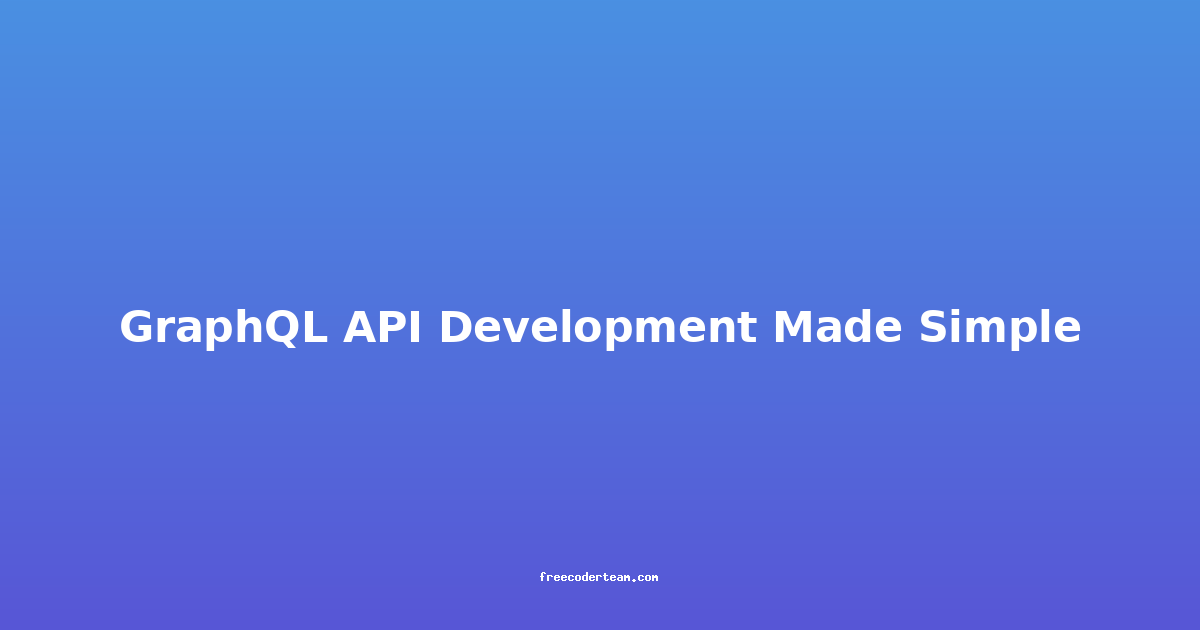GraphQL API Development Made Simple: A Comprehensive Guide
GraphQL, introduced by Facebook in 2015, has rapidly evolved into one of the most popular API development frameworks. Unlike traditional REST APIs, GraphQL provides a client-driven approach that allows developers to fetch exactly the data they need, reducing over-fetching and under-fetching issues. In this blog post, we will explore GraphQL from the ground up, including its core concepts, practical examples, best practices, and actionable insights for building robust and efficient APIs.
Table of Contents
- What is GraphQL?
- Why Use GraphQL?
- Core Concepts of GraphQL
- Schema Definition Language (SDL)
- Queries and Mutations
- Resolvers
- Setting Up a GraphQL Server
- Practical Example: Building a Simple GraphQL API
- Best Practices for GraphQL API Development
- Actionable Insights and Tips
- Conclusion
1. What is GraphQL?
GraphQL is a query language for APIs and a runtime for executing those queries with your existing data. It provides a flexible and efficient way to request and receive data from a server, allowing clients to specify exactly what they need in a single request.
GraphQL is particularly useful for applications where data requirements are dynamic and evolve over time. It offers a unified endpoint (/graphql) where clients can send queries to fetch data or mutations to modify data.
2. Why Use GraphQL?
- Flexible Data Fetching: Clients can request exactly the data they need, eliminating over-fetching and under-fetching.
- Single Endpoint: Reduces the complexity of managing multiple endpoints.
- Strong Typing: GraphQL uses a schema to define a contract between the client and server, ensuring type safety.
- Real-Time Capabilities: GraphQL can be easily integrated with real-time frameworks like Apollo Subscriptions.
- Reduced Round Trips: Complex data requirements can be fetched in a single request, reducing the number of API calls.
3. Core Concepts of GraphQL
3.1 Schema Definition Language (SDL)
The Schema Definition Language (SDL) is used to define the structure of your GraphQL API. It defines the types, fields, and operations (queries, mutations, and subscriptions) that clients can interact with.
Example: Basic Schema Definition
type Query {
hello: String
}
type Mutation {
sayHello(name: String!): String
}
Query: Defines the operations for fetching data.Mutation: Defines the operations for modifying data.hello: A field in theQuerytype that returns aString.sayHello: A field in theMutationtype that accepts aString(name) and returns aString.
3.2 Queries and Mutations
- Queries: Used to fetch data from the server.
- Mutations: Used to modify data on the server.
Example: Query
query {
hello
}
Example: Mutation
mutation {
sayHello(name: "John")
}
3.3 Resolvers
Resolvers are functions that define how to resolve fields in your schema. They are responsible for fetching or modifying data based on the query or mutation.
Example: Resolver for hello Field
const resolvers = {
Query: {
hello: () => "Hello, GraphQL!",
},
};
4. Setting Up a GraphQL Server
To set up a GraphQL server, you can use libraries like Apollo Server (for Node.js) or Graphql.NET (for .NET). Here’s how to get started with Apollo Server.
Installation
npm install apollo-server graphql
Basic Server Setup
const { ApolloServer } = require('apollo-server');
// Define the schema
const typeDefs = `
type Query {
hello: String
}
`;
// Define the resolvers
const resolvers = {
Query: {
hello: () => "Hello, GraphQL!",
},
};
// Create the Apollo Server
const server = new ApolloServer({ typeDefs, resolvers });
// Start the server
server.listen().then(({ url }) => {
console.log(`Server ready at ${url}`);
});
5. Practical Example: Building a Simple GraphQL API
Let’s build a simple GraphQL API for a todo application.
Schema Definition
type Todo {
id: ID!
title: String!
completed: Boolean!
}
type Query {
todos: [Todo]
todo(id: ID!): Todo
}
type Mutation {
createTodo(title: String!): Todo
updateTodo(id: ID!, completed: Boolean!): Todo
deleteTodo(id: ID!): Todo
}
Resolvers Implementation
const todos = [];
const resolvers = {
Query: {
todos: () => todos,
todo: (_, { id }) => todos.find(todo => todo.id === id),
},
Mutation: {
createTodo: (_, { title }) => {
const newTodo = { id: todos.length + 1, title, completed: false };
todos.push(newTodo);
return newTodo;
},
updateTodo: (_, { id, completed }) => {
const todo = todos.find(t => t.id === id);
if (!todo) return null;
todo.completed = completed;
return todo;
},
deleteTodo: (_, { id }) => {
const index = todos.findIndex(t => t.id === id);
if (index === -1) return null;
const deletedTodo = todos.splice(index, 1)[0];
return deletedTodo;
},
},
};
Complete Server Setup
const { ApolloServer } = require('apollo-server');
// Schema and resolvers (as defined above)
const typeDefs = `...`; // Paste the schema definition here
const resolvers = {...}; // Paste the resolvers implementation here
const server = new ApolloServer({ typeDefs, resolvers });
server.listen().then(({ url }) => {
console.log(`Server ready at ${url}`);
});
6. Best Practices for GraphQL API Development
6.1 Use Descriptive Naming Conventions
- Use clear and meaningful names for types, fields, and arguments.
- Avoid abbreviations unless they are widely understood.
6.2 Leverage Input Types for Complex Arguments
Input types allow you to group related fields together, making mutations more readable and maintainable.
Example:
input TodoInput {
title: String!
completed: Boolean!
}
type Mutation {
createTodo(input: TodoInput!): Todo
}
6.3 Use Enum Types for Fixed Choices
Enums provide a way to define a fixed set of values for a field. They improve type safety and readability.
Example:
enum TodoStatus {
PENDING
COMPLETED
}
type Query {
todos(status: TodoStatus): [Todo]
}
6.4 Use Directives for Reusable Logic
Directives allow you to add metadata to your schema, enabling reusable logic such as authentication or rate limiting.
Example:
directive @auth on QUERY | MUTATION | FIELD
6.5 Implement Pagination and Filtering
For large datasets, implement pagination and filtering to provide a better user experience and reduce load on the server.
Example:
type Query {
todos(page: Int, limit: Int, completed: Boolean): [Todo]
}
7. Actionable Insights and Tips
- Use GraphiQL or GraphQL Playground: These tools provide an interactive interface for testing and exploring your GraphQL API.
- Document Your Schema: Use tools like GraphQL Docs to generate documentation from your schema.
- Implement Validation: Use libraries like graphql-yoga for validation and error handling.
- Performance Optimization: Cache frequently accessed data or implement lazy loading for complex queries.
- Use Versioning: Since GraphQL is client-driven, versioning your schema is less critical, but still consider it for breaking changes.
8. Conclusion
GraphQL has transformed the way APIs are built by empowering clients to request exactly the data they need. Its flexibility, strong typing, and efficient data fetching make it an excellent choice for modern applications. By following the best practices outlined in this guide, you can build robust and maintainable GraphQL APIs that meet the evolving needs of your applications.
Whether you're building a simple todo app or a complex enterprise system, GraphQL provides the tools and flexibility to deliver data-driven experiences efficiently. Start exploring GraphQL today and unlock its full potential in your projects!
Feel free to experiment with GraphQL using tools like GraphQL Playground or Apollo Studio. Happy coding! 😊
Stay tuned for more in-depth guides and tutorials on advanced GraphQL topics!




